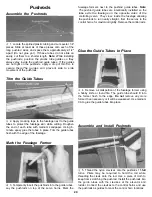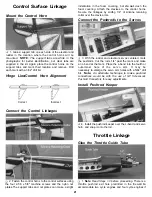
FLIGHT TRIMMING
A model is not a static object. Unlike a car, which you can only hunt
left or right on the road (technically, a car does yaw in corners, and pitches
when the brakes are applied), a plane moves through that fluid we call air in
all directions simultaneously. The plane may look like it's going forward, but it
could also be yawing slightly, slipping a little and simultaneously climbing or
diving a bit! The controls interact. Yaw can be a rudder problem, a lateral
balance problem or an aileron rigging problem. We must make many flights,
with minor changes between each, to isolate and finally correct the problem.
The chart accompanying this article is intended to serve as a
handy field reference when trimming your model. Laminate it in plastic and
keep it in you flight box. You just might have need to consult it at the next
contest! The chart is somewhat self-explanatory, but we will briefly run
through the salient points.
First, we are assuming that the model has been C.G. balanced
according to the manufacturer's directions. There's nothing sacred about that
spot — frankly, it only reflects the balance point where a prototype model
handled the way the guy who designed it thought it should. If your model's
wing has a degree more or less of incidence, then the whole balance formula
is incorrect for you. But, it's a good ballpark place to start.
The second assumption is that the model has been balanced
laterally. Wrap a strong string or monofilament around the prop shaft behind
the spinner, then tie the other end to the tail wheel or to a screw driven into
the bottom of the aft fuse. Make the string into a bridle harness and suspend
the entire model inverted (yes, with the wing on!). If the right wing always
drops, sink some screws or lead into the left wing tip, etc. You may be
surprised to find out how much lead is needed.
At this point the model is statically trimmed. It's only a starting
point, so don't be surprised if you wind up changing it all. One other critical
feature is that the ailerons must have their hinge gap sealed. If shoving some
Scotch tape or Monokote into the hinge gap to prevent the air from slipping
from the top of the wing to the bottom, and vice-versa, bothers you, then
don't do it.
To achieve the maximum lateral trim on the model, the hinge gap
on the ailerons should be sealed. The easiest way to do this is to disconnect
the aileron linkages, and fold the ailerons as far over the top of the wing as
possible (assuming they are top or center hinged). Apply a strip of clear tape
along the joint line. When the aileron is returned to neutral, the tape will be
invisible, and the gap will be effectively sealed. Depending on how big the
ailerons are, and how large a gaping gap you normally leave when you install
hinges, you could experience a 20 percent increase in aileron control
response just by this simple measure.
Your first flights should be to as certain control centering and
control feel. Does the elevator always come back to neutral after a 180 turn
or Split-S? Do the ailerons tend to hunt a little after a rolling maneuver? Put
the plane through its paces. Control centering is either a mechanical thing
(binding servos, stiff linkages, etc.). an electronic thing (bad servo resolution
or dead band in the radio system), or C.G. (aft Center of Gravity will make the
plane wander a bit). The last possibility will be obvious, but don't continue the
testing until you have isolated the problem and corrected it.
Let's get down to the task of trimming the model. Use the
tachometer every time you start the engine, to insure consistent results.
These trim flights must be done in calm weather. Any wind will only make the
model weather vane. Each "maneuver" on the list assumes that you will enter
it dead straight-and-level. The wings must be perfectly flat, or else the
maneuver will not be correct and you'll get a wrong interpretation. That's
where your observer comes in. Instruct him to be especially watchful of the
wings as you enter the maneuvers.
Do all maneuvers at full throttle. The only deviation from this is if
the plane will routinely be flown through maneuvers at a different power setting.
Let's commence with the "engine thrust angle" on the chart. Note
that the observations you make can also be caused by the C.G., so be
prepared to change both to see which gives the desired result. Set up a
straight-and-level pass. The model should be almost hands-off. Without
touching any other control on the transmitter, suddenly chop the throttle. Did
the nose drop? When you add power again, did the nose pitch up a bit? If so,
you need some down thrust, or nose weight. When the thrust is correct, the
model should continue along the same flight path for at least a dozen plane
lengths before gravity starts to naturally bring it down.
Do each maneuver several times, to make sure that you are getting
a proper diagnosis. Often, a gust, an accidental nudge on the controls, or just
a poor maneuver entry can mislead you. The thrust adjustments are a real
pain to make. On most models, it means taking the engine out, adding shims,
then reassembling the whole thing. Don't take shortcuts.
Don't try to proceed with the other adjustments until you have the
thrust line and/or C.G. correct. They are the basis upon which all other trim
settings are made.
Also, while you have landed, take the time to crank the clevises
until the transmitter trims are at neutral. Don't leave the airplane so that the
transmitter has some odd-ball combination of trim settings. One bump of the
transmitter and you have lost everything. The trim must be repeatable, and
the only sure way to do this is to always start with the transmitter control trims
at the middle.
The next maneuver is somewhat more tricky than it looks. To verify
C.G., we roll the model up to a 45 bank, then take our hands off the controls.
The model should go a reasonable distance with the fuse at an even keel. If
the nose pitches down, remove some nose weight, and the opposite if the
nose pitches up. The trick is to use only the ailerons to get the model up at a
45-degree bank. We almost automatically start feeding in elevator, but that's
a no-no. Do the bank in both directions, just to make sure that you are getting
an accurate reading of the longitudinal balance.
We now want to test the correct alignment of both sides of the
elevator (even if they aren't split, like a Pattern ship's, they can still be warped
or twisted). Yaw and lateral balance will also come into play here, so be
patient and eliminate the variables, one-by-one. The maneuver is a simple
loop, but it must be entered with the wings perfectly level. Position the
maneuver so that your assistant can observe it end-on. Always loop into the
wind. Do several loops, and see if the same symptom persists. Note if the
model loses heading on the front or back side of the loop. If you lose it on the
way up, it's probably an aileron problem, while a lose of heading on the way
back down is most likely a rudder situation.
After you get the inside loops going correctly, do the same
maneuver to the outside, entering from an inverted position. Before making
too many dramatic changes,glance at the remainder of the chart and note the
myriad combination of things we can do with just the ailerons. Each change
you make will affect all other variables!
Note that the Yaw test is the same looping sequences. Here,
however, we are altering rudder and ailerons, instead of the elevator halves.
We must repeat that many airplanes just will not achieve adequate lateral
trim without sealing the hinge gaps shut. The larger you make the loops (to a
point), the more discernable the errors will be.
The Lateral Balance test has us pulling those loops very tightly.
Actually, we prefer the Hammerhead as a better test for a heavy wing. Pull
straight up into a vertical and watch which wing drops. A true vertical is hard
to do, so make sure that your assistant is observing from another vantage
point. Note that the engine torque will affect the vertical fall off, as will rudder
errors. Even though we balance the wing statically before leaving for the field,
we are now trimming it dynamically.
The Aileron Coupling (or rigging), is also tested by doing
Hammerheads. This time, however, we want to observe the side view of the
model. Does the plane want to tuck under a bit? If so, then try trimming the
ailerons down a small bit, so that they will act as flaps. If the model tends to
want to go over into a loop, then rig both ailerons up a few turns on the
clevises. Note that drooping the ailerons will tend to cancel any washout you
have in the wing. On some models, the lack of washout can lead to some
nasty characteristics at low speeds.
The effects noted with the Aileron Coupling tests can also be
caused by an improperly set wing incidence. The better test for this is
knife-edge flight. If the model tends to pull upward, i.e., it swings toward a
nose up direction, then reduce the wing incidence. If the model tries to go off
heading toward the bottom side of the plane, then increase incidence.
Again, we reiterate that all of these controls are interactive. When
you change the wing incidence, it will influence the way the elevator trim is at
a given C.G. Re-trimming the wing will also change the rigging on the
ailerons, in effect, and they may have to be readjusted accordingly.
The whole process isn't hard. As a matter of fact it's rather
fun — but very time consuming. It's amazing what you will learn about why a
plane flies the way it does, and you'll be a better pilot for it. One thing we
almost guarantee, is that your planes will be more reliable and predictable
when they are properly trimmed out. They will fly more efficiently, and be less
prone to doing radical and surprising things. Your contest scores should
improve, too.
We wish to acknowledge the Orlando, Florida, club newsletter,
from which the basics of the chart presented here were gleaned.
Reprinted in part by Great Planes Model Manufacturing Company,
courtesy of Scale R/C Modeler magazine, Pat Potega, Editor, August 1983
issue.
See the Flight Trimming Chart on Page 30.
29



































